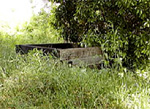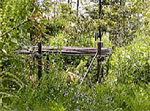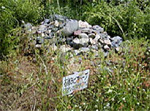
In accordance with our theme of coexistence with nature, Advantest established one of the largest biotopes to be created by a company in Japan, at our Gunma R&D Center in 2001, aiming to bring back to life the traditional rural landscape of the Kanto Plain.
Focusing on ponds, wetlands and streams, we have planted aquatic plants and trees that blend with the surrounding natural environment, aiming to form a network with that environment. It has grown into an ecosystem supporting diverse species of insects, birds and so forth.
The Advantest biotope is used for environmental education, enabling employees to learn about the importance of the global environment, and also as a place for communication with the local community.
-
*Biotope: This word combines the Greek words "Bio", which means life, and "Tope", which means a place.
What's New in the Biotope
We share seasonal observations of flowers and organisms that live in the biotope through videos and photos.
The videos can be viewed from the link “Biotope Quarterly” below.
Biotope Quarterly
The Advantest biotope serves as a habitat for various organisms.
This newsletter introduces the various animals and plants that live in our biotope along with videos and photos.
Four Seasons of Advantest's Biotope
We've compiled a year's footage of our biotope into a single video showcasing the beautiful natural landscape and the creatures that live there. Watch the biotope change with the seasons!
Clicke here for the Biotope Introduction Video.
(running time : about 3 minutes)
Biotope Quarterly Archive
-
7/2024
-
2/2024
-
12/2023
-
8/2023
-
3/2023
-
12/2022
-
8/2022
-
7/2022
-
5/2021
-
9/27/2018
-
4/17/2018
-
12/8/2017
-
9/12/2017
-
4/21/2017
-
1/31/2017
-
11/18/2016
-
7/22/2016
-
3/31/2016
Biotope description
-
*Ecotone: An environmental transition zone bordering on a different environment, such as the water's edge, grasslands, woodlands etc.
Artificial insect habitats
We have put in place artificial insect habitats* within the biotope area, to support a variety of living creatures, and have kept track of how they are being used.
-
*Artificial insect habitats: piles of logs, stones etc.
Wooden artificial insect habitat
The surface is dry but it is moist inside, so reptiles and insects live and lay eggs there.
Species observed
Reptiles: snakes (eggs), Japanese grass lizard etc.
Insects: small stag beetle (larvae), assassin bug, seven-spotted lady beetle, etc.

Bamboo artificial insect habitat
Bundles of cut bamboo sticks were put on the ground and above ground. Insects live in the bamboo and in the gap between the bundles.
Species observed
Insects: a kind of wasp (Isodontia nigella), solitary wasp (Anterhynchium flavomarginatum micado), type of earwig (Carcinophora marginalis), etc.

Stone artificial insect habitat
A house in which large and small stones are arranged in a pile. Insects live under and in the gaps between the stones.
Species observed
Insects: Enma cricket, Loxoblemmus campestris, Panagaeus japonicus Chaudoir, etc.
